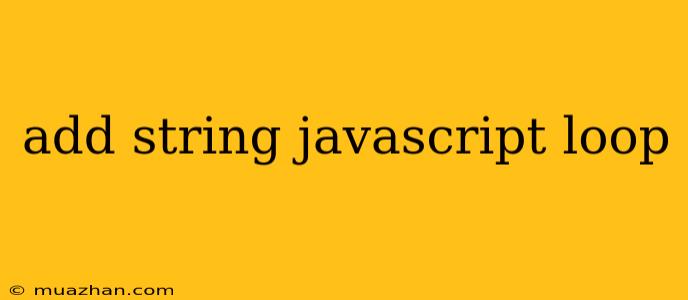Adding Strings in JavaScript Loops
Adding strings within loops in JavaScript is a fundamental programming concept. It involves concatenating strings iteratively to build a larger string based on the loop's iterations. This technique finds numerous applications, from creating dynamic content to generating custom output based on data.
1. Using the += Operator
The += operator provides a concise way to append strings within a loop. It combines the existing string with the new string on each iteration.
let result = "";
const names = ["Alice", "Bob", "Charlie"];
for (let i = 0; i < names.length; i++) {
result += names[i] + ", ";
}
// result = "Alice, Bob, Charlie, ";
In this example, the loop iterates through the names array. On each iteration, the current name is appended to the result string along with a comma and a space.
2. Using the join() Method
The join() method offers a more elegant and efficient approach for concatenating strings within arrays. It takes a separator as an argument and joins all elements of the array into a single string.
const names = ["Alice", "Bob", "Charlie"];
const result = names.join(", ");
// result = "Alice, Bob, Charlie"
This code directly joins the elements of the names array using a comma and a space as separators.
3. Using Template Literals (ES6)
Template literals, introduced in ES6, provide a modern and flexible way to format strings. They allow you to embed expressions within backticks ( ).
const names = ["Alice", "Bob", "Charlie"];
let result = "";
for (let i = 0; i < names.length; i++) {
result += `${names[i]}, `;
}
// result = "Alice, Bob, Charlie, ";
Within the template literal, we use the ${} syntax to insert the current name into the string on each iteration.
Key Considerations
- Efficiency: While the
+=operator is straightforward, it can be less efficient for large strings due to repeated string creation. Thejoin()method generally performs better for large arrays. - Readability: Template literals can improve the readability of your code, especially when working with complex string formatting.
- Context: The choice between these methods depends on your specific requirements and the size and complexity of your data.
By understanding these techniques, you can effectively manipulate and build strings within JavaScript loops for various purposes. Remember to choose the method that best suits your situation and prioritize readability and efficiency.
